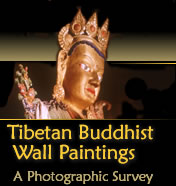








|
MUSTANG
- THE LAND SETTING
AND DAILY LIFE With wood extremely scarce and precious, the houses and gompas of Mustang are made of dried mud and its capital, Lo Monthang, is no exception. Even the royal palace and the great gompas are earthen, mud-brick structures. Lo Monthang is a walled, medieval town, and its wall is earthen as well. In many respects, life in Mustang still has a medieval or at least a pre-modern quality. A type of serfdom was abolished only late in the twentieth century. Most villages lack electricity, indoor plumbing and running water, and telephone service. Village lanes are unpaved. Houses serve as both barn or byre and also home, with animals on the ground floor and the family living above. Each morning in Lo Monthang, the animals--horses, goats, sheep--are driven out through the single gate in the town wall to graze. During the day, the villages are nearly empty: the women are in the surrounding fields, weeding and tending the crops, and the men are either out with the herds or away on trading or transport expeditions. In Lo Monthang, which has a primary school (as well as a school for novice monks), some children are at their lessons, while others are out tending herds of goats. Lo
Monthang is at 13,000 feet and Mustang's other villages are almost
that high; at those altitudes, the main crops are barley, potatoes,
and buckwheat. Mustard is also grown, but used mainly for oil. In
late afternoon, everyone returns to town--animals stream back through
the gate, children rollick in the lanes and the main square, and
women gather briefly outside their houses to chat with their neighbors.
Winters in Mustang are severe, and in late October or November,
many people leave the region, some going to Pokhara or Kathmandu,
others on trading trips, to return in April or early May to their
Mustang homes.
[Contents] [Introduction] [Jampa] [Thubchen] [Luri] [Site Index] [Home] Copyright © 2003 Philip and Marcia R. Lieberman |
